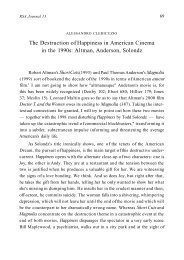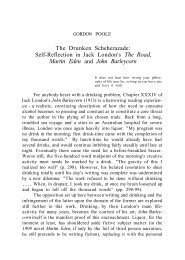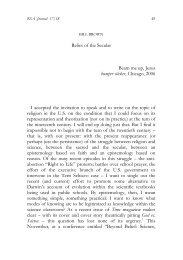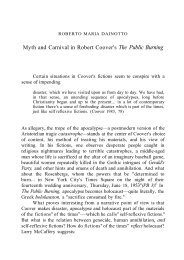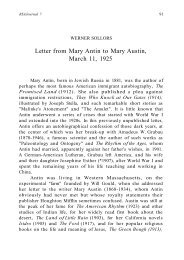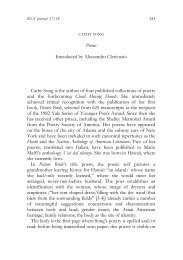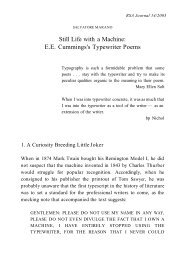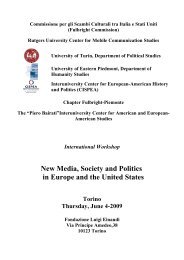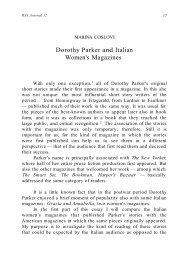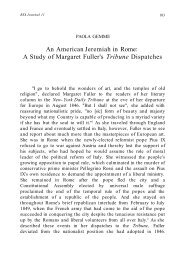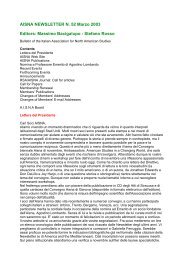If "Bartok in Udaipur" is indicative of Tarn's poetry of the ... - aisna
If "Bartok in Udaipur" is indicative of Tarn's poetry of the ... - aisna
If "Bartok in Udaipur" is indicative of Tarn's poetry of the ... - aisna
You also want an ePaper? Increase the reach of your titles
YUMPU automatically turns print PDFs into web optimized ePapers that Google loves.
100 Giordano<br />
<strong>If</strong> "<strong>Bartok</strong> <strong>in</strong> Udaipur" <strong>is</strong> <strong>in</strong>dicative <strong>of</strong> <strong>Tarn's</strong> <strong>poetry</strong> <strong>of</strong> <strong>the</strong> N<strong>in</strong>eties,<br />
it prom<strong>is</strong>es new, excit<strong>in</strong>g, multicultural journeys, both for <strong>the</strong> poet and for<br />
<strong>the</strong> reader.<br />
Udaipur, <strong>in</strong> <strong>the</strong> Indian state <strong>of</strong> Rajastan, <strong>is</strong> a city <strong>of</strong> XVII century<br />
marble palaces, gardens and bridges built on <strong>the</strong> <strong>is</strong>lands <strong>of</strong> beautifulLake<br />
Picbola. A d<strong>is</strong>t<strong>in</strong>gu<strong>is</strong>hed young traveller, Mircea Eliade, saw it as an<br />
example <strong>of</strong> that idyllic India "where one could be happy just to rest and<br />
look around." 1<br />
A perfect place, <strong>the</strong>n, to exemplify Nathaniel <strong>Tarn's</strong> ideal journey.<br />
As he said <strong>in</strong> an article a few years ago, "Noth<strong>in</strong>gcomforts me morethana<br />
great site, a great exhibition, a great build<strong>in</strong>g. <strong>If</strong> it <strong>is</strong> d<strong>is</strong>tant, far, hard <strong>of</strong><br />
access, so much <strong>the</strong> better." 2 For Tarn hassuccessfully reversed h<strong>is</strong> <strong>in</strong>itial<br />
feel<strong>in</strong>g <strong>of</strong> be<strong>in</strong>g divided among several cultures by becom<strong>in</strong>g, <strong>in</strong> h<strong>is</strong> words,<br />
"a compulsive traveller", an "<strong>in</strong>ternational wander<strong>in</strong>g mestizo." 3 Udaipur<br />
<strong>is</strong> one <strong>of</strong> a thousand places Tarn has v<strong>is</strong>ited and lived <strong>in</strong> while serv<strong>in</strong>g h<strong>is</strong><br />
multiple apprenticeship. A Jew born <strong>in</strong> Par<strong>is</strong> <strong>of</strong> a French-Rumanian<br />
mo<strong>the</strong>r and a Lithuanian-Engl<strong>is</strong>h fa<strong>the</strong>r, he went to school <strong>in</strong> Belgium,<br />
<strong>the</strong>n <strong>in</strong> England for n<strong>in</strong>e years. He was <strong>in</strong> Par<strong>is</strong> <strong>in</strong> <strong>the</strong> late Forties, where<br />
he frequented André Breton, wrote <strong>poetry</strong> <strong>in</strong> French, and studied anthropology<br />
with Marcel Griaule and Claude Lévi-Strauss. He later didgraduate<br />
work <strong>in</strong> Chicago with RobertRedfieldandstudied Santerìa <strong>in</strong> Cuba before<br />
go<strong>in</strong>g to Guatemala to work on a Mayan site and to Japan to do research<br />
on Buddh<strong>is</strong>m. After that, he lived and taught anthropology <strong>in</strong> London<br />
until 1967 when he became a full-time poet and, for two enthusiastic<br />
years, a publ<strong>is</strong>her <strong>of</strong> Charles Olson and <strong>the</strong> San Franc<strong>is</strong>co Rena<strong>is</strong>sance.<br />
The United States came next: Buffalo, Pr<strong>in</strong>ceton, New Hope, Rutgers<br />
University where he taught Comparative Literature, and Alaska where he
RSA Journal 2 101<br />
spentsummers becom<strong>in</strong>g acqua<strong>in</strong>ted with a Native American community.<br />
In 1970 he acquired American citizenship. In 1985 he went <strong>in</strong>to early<br />
retirement andmoved to New Mexico with h<strong>is</strong> wife, poet Janet Rodney, so<br />
as to devote himself to <strong>poetry</strong>—and more travell<strong>in</strong>g.<br />
"<strong>Bartok</strong> <strong>in</strong> Udaipur" <strong>is</strong> a mature expression <strong>of</strong> Nathaniel <strong>Tarn's</strong><br />
poetic quest. As poet-anthropolog<strong>is</strong>t (but also archaeolog<strong>is</strong>t, h<strong>is</strong>torian,<br />
geographer, ecolog<strong>is</strong>t), he <strong>is</strong> <strong>the</strong> "<strong>in</strong>sider/outsider" 4 who succeeds <strong>in</strong> merg<strong>in</strong>g<br />
<strong>the</strong> scientific desire for an objective (presumedly) understand<strong>in</strong>g <strong>of</strong> <strong>the</strong><br />
O<strong>the</strong>r, with <strong>the</strong> poetic desire to be <strong>the</strong> O<strong>the</strong>r - a position which Tarn<br />
himself ironically sees as a Dr. Jekyll/Mr. Hyde split. 5 Th<strong>is</strong> attitude<br />
perfectly represents that aspiration to <strong>the</strong> creation <strong>of</strong> a multicultural,<br />
syncret<strong>is</strong>tic Weltliteratur which <strong>is</strong> <strong>the</strong> bas<strong>is</strong> <strong>of</strong> <strong>the</strong> "ethnopoetic" d<strong>is</strong>course.<br />
6 We can follow its development from <strong>the</strong> first poems <strong>of</strong> Old<br />
Savage/Young City (1964), through Beautiful Contradictions (1969) 7 to<br />
<strong>the</strong> last collection, See<strong>in</strong>g America First (1989).<br />
Tarn, <strong>the</strong> student<strong>of</strong> spirit possession, sees <strong>the</strong> shaman asa model for<br />
<strong>the</strong>poetas<strong>the</strong>y both travel a symbolicjourney to <strong>the</strong> underworld <strong>in</strong> search<br />
<strong>of</strong> past knowledge and w<strong>is</strong>dom. Only <strong>the</strong>n do <strong>the</strong> Voices <strong>of</strong> <strong>the</strong> O<strong>the</strong>r<br />
speak through <strong>the</strong> poet. Tarn calls h<strong>is</strong> own highly experimental and<br />
syncretic render<strong>in</strong>g <strong>of</strong> th<strong>is</strong> experience multi-voiced <strong>poetry</strong>; 8<br />
its most<br />
ambitious expression <strong>is</strong> to be found <strong>in</strong> <strong>the</strong> long poem Lyrics for <strong>the</strong> Bride<br />
<strong>of</strong> God (1975). Th<strong>is</strong> Ulysses-like journey <strong>in</strong> search <strong>of</strong> <strong>the</strong> female creative<br />
pr<strong>in</strong>ciple marks a farewell to Europe and <strong>the</strong> choice <strong>of</strong> a new mo<strong>the</strong>rland.<br />
Through <strong>the</strong> many "voices" <strong>of</strong> mythology, h<strong>is</strong>tory, archaeology, geography,<br />
and contemporary society, <strong>in</strong> a dialogue between Eros and Logos, Tarn<br />
searches for a new <strong>poetry</strong> <strong>in</strong> a new American language. 9<br />
Alashka (1979), a poeticduet writtenwith Janet Rodney, an androgynous<br />
fusion <strong>of</strong> male and female voices, signals <strong>the</strong> end <strong>of</strong> <strong>Tarn's</strong> experimental<br />
phase. H<strong>is</strong> <strong>poetry</strong> <strong>of</strong> <strong>the</strong> Eighties <strong>is</strong> more accessible to <strong>the</strong> reader,<br />
but <strong>the</strong> <strong>the</strong>mes rema<strong>in</strong> constant (<strong>the</strong> quest for new sources <strong>of</strong> creativity<br />
through symbolic encounters with <strong>the</strong> archetypes <strong>of</strong> <strong>the</strong> journey to <strong>the</strong><br />
underworld, <strong>in</strong>cest with <strong>the</strong> Great Mo<strong>the</strong>r, and androgyny) as does <strong>the</strong><br />
aspiration toward syncret<strong>is</strong>m.<br />
The poems <strong>of</strong> At <strong>the</strong> Western Gates (1985) travel to <strong>the</strong> land, <strong>the</strong><br />
ocean, <strong>the</strong> animals, <strong>the</strong> vegetation and <strong>the</strong> mythology <strong>of</strong> Baia California, as<br />
well as to <strong>the</strong> Mayan ru<strong>in</strong>s <strong>of</strong> Palenque, to Alaska and to Japan. Tarn<br />
chooses <strong>the</strong> whaleasguid<strong>in</strong>g symbol; <strong>the</strong> poetic journey to <strong>the</strong> underworld
102 Giordano<br />
and to <strong>the</strong> orig<strong>in</strong>s <strong>of</strong> creativity takes <strong>the</strong> form <strong>of</strong> an encounter with<br />
Leviathan, <strong>in</strong> <strong>the</strong> poem <strong>of</strong> <strong>the</strong> man swallowed by <strong>the</strong> whale-shaman: "he<br />
lay <strong>in</strong>side <strong>the</strong> whale/ and wrote, <strong>in</strong> h<strong>is</strong> death, terrible hymns / which no<br />
amount <strong>of</strong> pa<strong>in</strong> / had ever torn from him." 10<br />
The "narrative poems" and <strong>the</strong> "rectangle poems" <strong>of</strong> <strong>Tarn's</strong> latest<br />
volume, See<strong>in</strong>g America First (1989) address <strong>the</strong>mselves to h<strong>is</strong> now<br />
settled relation with America—a land where symbolic dimensions <strong>in</strong>habit<br />
<strong>the</strong> commonplace, and Persephones may be seen tread<strong>in</strong>g on back-yard<br />
flowerbeds. 11<br />
F.G.<br />
1 Mircea Eliade, India (Bucuresti, 1934; Tor<strong>in</strong>o: Bollati Bor<strong>in</strong>ghieri, 1991) 55.<br />
2 Nathaniel Tarn, "Fresh Frozen Fenix: Random Notes on <strong>the</strong> Sublime, <strong>the</strong><br />
Beautiful and <strong>the</strong> Ugly <strong>in</strong> <strong>the</strong> Postmodern Era," New Literary H<strong>is</strong>tory 17 (1984-85):<br />
148.<br />
3 Nathaniel Tarn, "Child as Fa<strong>the</strong>r to Man <strong>in</strong> <strong>the</strong> American Universe," American<br />
Poetry 2.2 (1984): 71, rpt, Views from <strong>the</strong> Weav<strong>in</strong>g Mounta<strong>in</strong>. Selected Essays <strong>in</strong><br />
Politics and Anthropology (Albuquerque: U <strong>of</strong> New Mexico P, 1991) 58.<br />
4 Dor<strong>is</strong> Sommer, "America as Desire(d): Nathaniel <strong>Tarn's</strong> Poetry <strong>of</strong> <strong>the</strong> Outsider<br />
as Insider," American Poetry 2.1 (1984): 13-35.<br />
5 Nathaniel Tarn, "Dr. Jeckyll, <strong>the</strong> Anthropolog<strong>is</strong>t Emerges and Marches <strong>in</strong>to<br />
<strong>the</strong> Notebook <strong>of</strong> Mr. Hyde, <strong>the</strong> Poet," Conjunctions 6 (1985): 266-81.<br />
6 Nathaniel Tarn, "Dr. Jeckyll"; see also Fedora Giordano, Etnopoetica (Roma:<br />
Bulzoni, 1988).<br />
7 Nathaniel Tarn, BeautifulContradictions; <strong>in</strong> "One," Tarn manta<strong>in</strong>s that poets<br />
have "no alternative to / tak<strong>in</strong>g <strong>the</strong> whole world as our mo<strong>the</strong>r." Atitlan/Alashka<br />
(Boulder: Brillig Works, 1979): 57, <strong>in</strong>cludes <strong>Tarn's</strong> selected poems and prose, as well<br />
as poems written by Tarn and Janet Rodney.<br />
8 See <strong>the</strong> special <strong>is</strong>sue <strong>of</strong> Boundary 2 (1975) on Tarn.<br />
9 For an analys<strong>is</strong> <strong>of</strong> Lyrics for <strong>the</strong> Bride <strong>of</strong> God (New York: New Directions,<br />
1975) see Fedora Giordano, "II mito come metal<strong>in</strong>guaggio nella poesia di Nathaniel<br />
Tarn," Letterature d'America 5.2 (1984): 95-126.<br />
10 Nathaniel Tarn, "Journal <strong>of</strong> <strong>the</strong> Laguna de San Ignacio," <strong>in</strong> At <strong>the</strong> Western<br />
Gates (Santa Fe: Tooth <strong>of</strong> Time Books, 1985) 3.<br />
11 See<strong>in</strong>g America First (M<strong>in</strong>neapol<strong>is</strong>: C<strong>of</strong>fee House Press, 1989).



